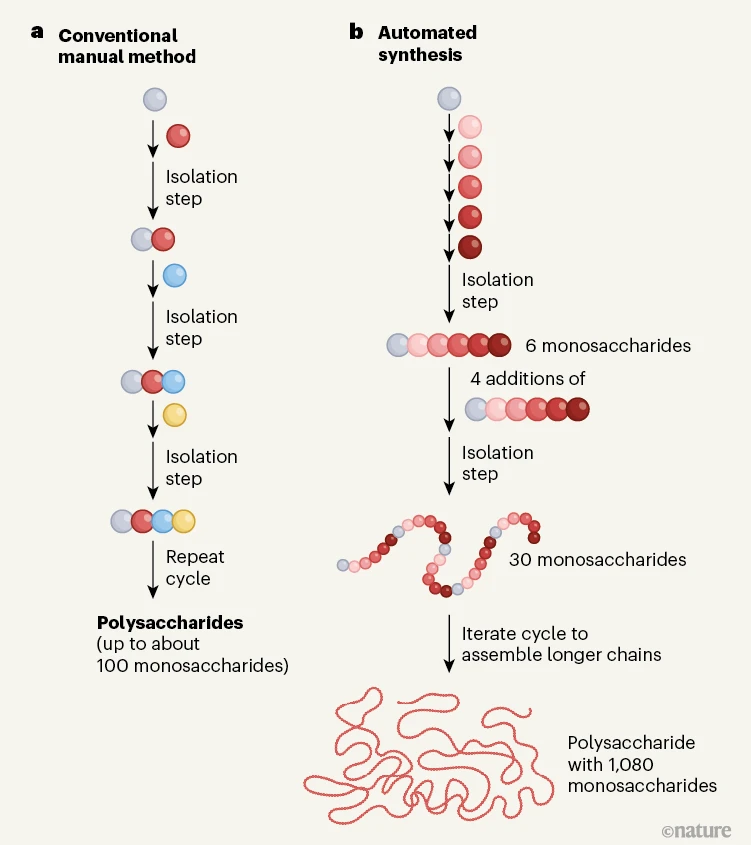As we all know, carbohydrates, like nucleic acids, proteins, and lipids, are one of the four important material families that constitute complex organisms. They are not only the sources of energy for organisms, but also play a key role in biological signal transmission, cell recognition, and structural components of organisms. They participate in almost all life processes of multicellular organisms.
Most naturally occurring sugars in organisms exist in the form of polysaccharides. Due to their inherent structural complexity, the study of their biological activities has become extremely complex. Therefore, carbohydrates with well-defined structures are in great demand in biological research, but their synthesis is difficult, time-consuming, and laborious. In particular, the synthesis of polysaccharides has always been a challenging task. Professor Xinshan Ye’s team from the State Key Laboratory of Natural and Biomimetic Drugs of Peking University published a research paper entitled “Automated solution phase multiple synthesis of complex glycans up to a 1,080-mer” in Nature Synthesis, and reported their breakthrough progress in automated synthesis of carbohydrates.

Professor Peng George Wang’s research team from the School of Medicine at the Southern University of Science and Technology (SUSTech) were recently invited by Nature to publish a News & Views column article on Prof. Ye’s results on developing an automated carbohydrate synthesizer that could help probe carbohydrates’ biological functions.
Their review published in Nature was entitled “Machine assembly of carbohydrates with more than 1000 sugar units”. Over the past 10 years, this column has published about 20 review papers from scholars and research teams from mainland China. This is also the first time that a SUSTech-published article has appeared in the News & Views column of Nature.

Figure 1. Carbohydrate synthesis. a) The conventional strategy for carbohydrate synthesis: target molecules are assembled by the sequential addition of monosaccharides (spheres) to a growing chain. Each addition, and the subsequent isolation of the resulting product, is carried out manually, limiting the size of polysaccharides that can be assembled. b) An automated ‘multiplicative’ strategy carried out by machine reported by Ye’s group: The chemistry is optimized so that several additions of monosaccharides (or larger building blocks) can occur in one reaction vessel before the resulting product is isolated, greatly reducing the number of isolation steps. The product of each cycle of the process is used as the building block in the next cycle, preparing a polysaccharide containing 1,080 monosaccharides.
In the review article, after analyzing the results achieved by Ye’s team compared to methods of traditional sugar synthesis and automated machine synthesis reported in previous literatures, Prof. Wang’s group commented positively on the automatic sugar synthesis technology in the liquid phase. They affirmed the advantages of one-pot continuous oligosaccharide synthesis based on the “pre-activation” strategy of sugar donors by the automated sugar synthesizer designed and developed by Ye’s team. This technology can promote rapid development in the field of glycobiology and pharmaceutical chemistry, and even material science.
The automated synthesizer consists of three key parts: a synthesis system, an online monitoring system (composed of sensors tracking the reaction process), and programmable logic control system. In the synthesis system, the reactor is equipped with a magnetic stirrer, a thermostatic controller, and a light source. The light source can realize the sugar synthesis reaction induced by visible light, which provides a green and sustainable method for the synthesis of sugars. It is worth noting that the automatic injection system controls the transportation of reactants, reagents, and solvents. It not only uses an online reaction monitoring method and self-tuning algorithms to accurately inject reaction components, but also designs self-cleaning channel procedures to avoid cross-contamination of samples and side reactions.
The idea of automated synthesis of carbohydrates is that monosaccharide receptors and donors with equal equivalents can self-assemble into disaccharides in the presence of chemical promoters or photo activators. After this reaction step is repeated many times, in principle, a large number of carbohydrates with defined structures can be prepared in one pot. Subsequently, Ye and co-workers used an automatic multiplication synthesis strategy with oligosaccharides instead as self-assembled sugar units to accelerate the preparation of polysaccharides. They prepared a polysaccharide containing 1,080 sugar monomers, which is probably the longest polysaccharide with a clear structure prepared so far. This synthesis instrument no longer requires highly skilled personnel to synthesize sugars manually, which avoids the complex steps of multiple separation and purification of intermediates, saving a lot of time and avoiding the excessive use of expensive sugar intermediates.
In this article, Prof. Wang’s team further raised the question of whether this synthesis instrument can combine chemical and enzymatic synthesis methods to prepare glycoproteins with well-defined structures. Antibody-drug conjugates (ADC) have great prospects in the targeted killing of tumor cells. Combined with the hot areas in the field of biomedicine, it is meaningful to attach well-defined carbohydrates to antibodies in ADC. In a word, polysaccharide synthesis is always a major challenge. This automated sugar synthesis technology fills the gap in the development of a liquid-phase sugar synthesis apparatus at home and abroad, and is an important milestone significance in the synthesis field.
Research Asst. Prof. Hanchao Cheng is the first author of the paper. Professor Peng George Wang is the corresponding author, and SUSTech is the affiliated unit.
As an expert in the field of sugar chemistry, Prof. Wang has made many remarkable achievements in the areas of glycochemistry, glycobiology, glycoproteomics, and mRNA medicine. He has published more than 400 academic papers in international academic journals, including Nature, Nature Methods, Nature Protocols, Nature Chemical Biology, Nature Communication, Journal of the American Chemical Society, and Angewandte Chemie. He has also published 19 patents and written seven academic monographs.
Paper link: https://www.nature.com/articles/d41586-022-02927-x
To read all stories about SUSTech science, subscribe to the monthly SUSTech Newsletter.
Proofread ByAdrian Cremin, Yingying XIA
Photo By